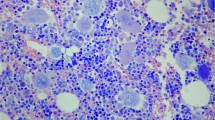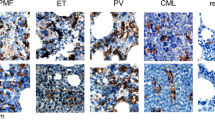Abstract
The aim of this review is to evaluate morphological characteristics of the different subtypes of chronic myeloproliferative disorders (MPDs) derived by applying immunohistochemical and morphometric techniques to bone marrow biopsies and to combine these results with relevant clinical parameters. In comparison to control specimens, a significant decrease in erythroid precursors is determinable in chronic myeloid leukemia (CML), while this cell lineage is most prominent in polycythemia vera (PV) and moderately to markedly reduced in idiopathic myelofibrosis (IMF). On the other hand, neutrophilic granulopoiesis shows a predominance in CML and a relevant increase in PV, but no conspicuous changes are detectable in essential thrombocythemia (ET). CML is characterized by a prevalent growth of dwarflike micromegakaryocytes, occurring in particular in the so-called megakaryocyte-rich subtypes (about 30%). This finding differs significantly from the pleomorphous aspect, i.e., clusters of small to giant-sized megakaryocytes in PV and the grossly abnormal (dysplastic) appearance of this cell lineage in patients with IMF. Similar cytological abnormalities of megakaryopoiesis consistent with maturation defects are never encountered in ET. The incidence of mature (resident) macrophages (phagocytic reticular cells) is significantly enhanced in IMF in comparison to the other MPDs and controls. Moreover, there is a striking difference in the density of reticulin-collagen fibers, ranging from normal (ET) to extreme values (IMF). In IMF more than 80% of the patients present with some degree of myelofibrosis-osteosclerosis at diagnosis, while the rest show an initial prefibrotic, hypercellular stage. This feature deserves special attention since, when accompanied by thrombocythemia, it may simulate ET. Sequential bone marrow biopsies in patients with IMF disclose that evolution of myelofibrosis is progressive, but occurs at a variable and unpredictable speed. A synoptical approach regarding clinical diagnosis and histological subtyping of MPDs is explicitly recommended and demonstrated by sets of diagnostic criteria. This rationale requires equal consideration of laboratory data and morphology by clinicians to include well-defined subtypes of MPDs into prospective management studies. Furthermore, it may even warrant follow-up studies and repeated bone marrow examinations in initially unclassifiable cases.
Similar content being viewed by others
Author information
Authors and Affiliations
Additional information
Received: October 19, 1998 / Accepted: July 19, 1999
Rights and permissions
About this article
Cite this article
Thiele, J., Kvasnicka, H. & Fischer, R. Histochemistry and morphometry on bone marrow biopsies in chronic myeloproliferative disorders – aids to diagnosis and classification. Ann Hematol 78, 495–506 (1999). https://doi.org/10.1007/s002770050546
Issue Date:
DOI: https://doi.org/10.1007/s002770050546




